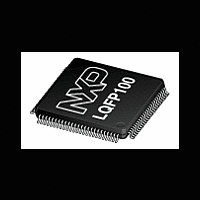LPC2361_62 NXP Semiconductors, LPC2361_62 Datasheet - Page 28

LPC2361_62
Manufacturer Part Number
LPC2361_62
Description
The LPC2361/2362 microcontrollers are based on a 16-bit/32-bit ARM7TDMI-S CPU with real-time emulation that combines the microcontroller with up to 128 kB of embedded high-speed flash memory
Manufacturer
NXP Semiconductors
Datasheet
1.LPC2361_62.pdf
(64 pages)
NXP Semiconductors
LPC2361_62
Product data sheet
7.23.3 Wake-up timer
7.23.4 Power control
Following the PLL input divider is the PLL multiplier. This can multiply the input divider
output through the use of a Current Controlled Oscillator (CCO) by a value ‘M’, in the
range of 1 through 32768. The resulting frequency must be in the range of 275 MHz to
550 MHz. The multiplier works by dividing the CCO output by the value of M, then using a
phase-frequency detector to compare the divided CCO output to the multiplier input. The
error value is used to adjust the CCO frequency.
The PLL is turned off and bypassed following a chip Reset and by entering Power-down
mode. PLL is enabled by software only. The program must configure and activate the PLL,
wait for the PLL to Lock, then connect to the PLL as a clock source.
The LPC2361/2362 begins operation at power-up and when awakened from Power-down
and Deep power-down modes by using the 4 MHz IRC oscillator as the clock source. This
allows chip operation to resume quickly. If the main oscillator or the PLL is needed by the
application, software will need to enable these features and wait for them to stabilize
before they are used as a clock source.
When the main oscillator is initially activated, the wake-up timer allows software to ensure
that the main oscillator is fully functional before the processor uses it as a clock source
and starts to execute instructions. This is important at power-on, all types of Reset, and
whenever any of the aforementioned functions are turned off for any reason. Since the
oscillator and other functions are turned off during Power-down and Deep power-down
modes, any wake-up of the processor from Power-down modes makes use of the
wake-up timer.
The wake-up timer monitors the crystal oscillator to check whether it is safe to begin code
execution. When power is applied to the chip, or when some event caused the chip to exit
Power-down mode, some time is required for the oscillator to produce a signal of sufficient
amplitude to drive the clock logic. The amount of time depends on many factors, including
the rate of V
characteristics (if a quartz crystal is used), as well as any other external circuitry (e.g.,
capacitors), and the characteristics of the oscillator itself under the existing ambient
conditions.
The LPC2361/2362 supports a variety of power control features. There are four special
modes of processor power reduction: Idle mode, Sleep mode, Power-down mode, and
Deep power-down mode. The CPU clock rate may also be controlled as needed by
changing clock sources, reconfiguring PLL values, and/or altering the CPU clock divider
value. This allows a trade-off of power versus processing speed based on application
requirements. In addition, Peripheral Power Control allows shutting down the clocks to
individual on-chip peripherals, allowing fine tuning of power consumption by eliminating all
dynamic power use in any peripherals that are not required for the application. Each of the
peripherals has its own clock divider which provides even better power control.
The LPC2361/2362 also implements a separate power domain in order to allow turning off
power to the bulk of the device while maintaining operation of the RTC and a small SRAM,
referred to as the battery RAM.
DD(3V3)
All information provided in this document is subject to legal disclaimers.
ramp (in the case of power-on), the type of crystal and its electrical
Rev. 5 — 25 October 2011
Single-chip 16-bit/32-bit MCU
LPC2361/62
© NXP B.V. 2011. All rights reserved.
28 of 64














